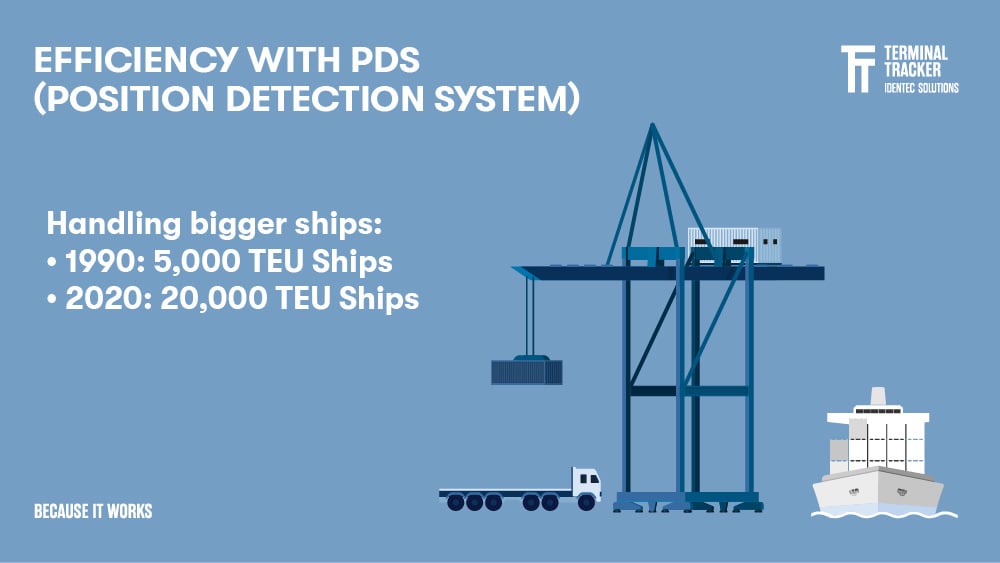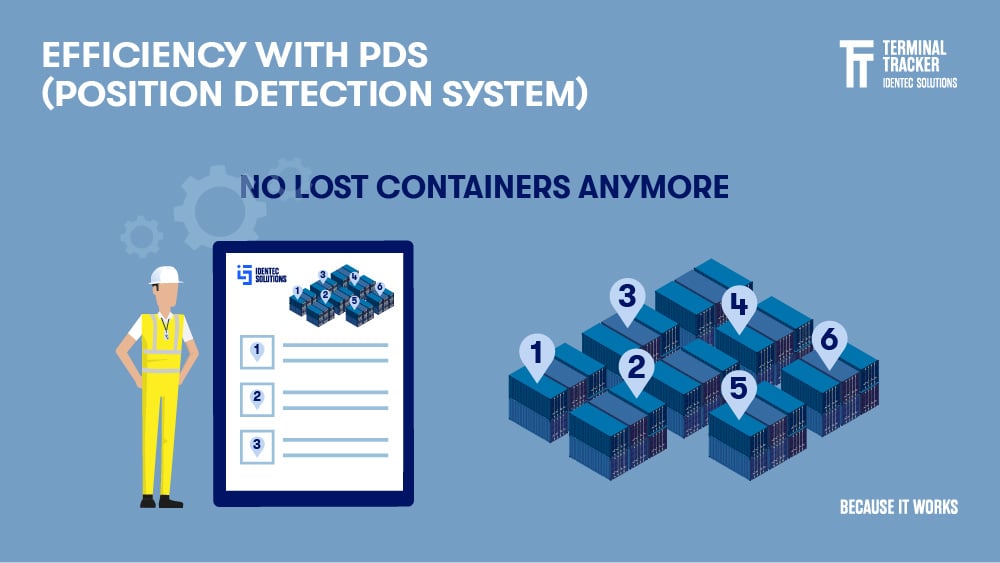Port Position Detection System: Never lose a container again
| Written by Mark Buzinkay
A Position Detection System (PDS) is an essential tool for port operators who need to track containers and maintain an accurate inventory of containers.
In this article we explain why and how to choose a PDS to meet your port's specific needs.

No video selected
Select a video type in the sidebar.
Table of contents:
- Position Detection System: Traffic and Operations
- What is a Position Detection System?
- What are the Main Parts of a PDS?
- Why is Tracking Containers With PDS Essential?
- Choosing the Right PDS for Your Port
- FAQ
- Takeaway
- Glossary
"A port position detection system leads to improved operational transparency and accountability, fostering a more efficient and secure terminal environment."
Julian Galvis, Regional Head Americas
As the world's trade has grown, so has the size and number of container ships. The average capacity of these vessels has increased from 5,000 twenty-foot equivalent units (TEU) in 1990 to over 24,000 TEU today – the currently biggest one being the MSC Irina with enough space for 24,346 containers (1). As a result, ports have had to expand their operations and infrastructure to keep up with this demand.
Position Detection System: Traffic and operations
With the ever-increasing size of container ships and the number of containers being handled at port facilities, these operations must be run as efficiently as possible. One way to do this is using a Position Detection System (PDS).
Besides assuring visibility and integrity of the container inventory, a PDS can also be used to monitor container handling equipment (CHE) within the port – helping to ensure that the assets are being allocated in an efficient manner.
Several different position detection systems are available on the market today. Some systems use DGPS technology, while others utilize radio frequency identification (RFID) tags. In order to choose the right PDS for your needs, it is essential to consult with an experienced provider who can assess your specific requirements and recommend the best solution for your facility (learn more about implementing smart port technology).
What is a Position Detection System?
A position detection system is a computerized system that tracks the movement of assets within a port. A reliable PDS will enable accurate and reliable position detection of container handling equipment (CHE) and, consequently, containers in complex terminal environments. The system collects data on the location of each CHE, matches it with the yard position and passes it to the terminal operation system (TOS) where it will be asigned to the container being moved.. Port operators can then use this information to improve their operations' efficiency and provide better customer service.
When it comes to handing over a container from one piece of equipment to another, a PDS can go the extra mile by automatically detecting the vehicle that approached the CHE to get the container. The operation can also be optimized by sending regular messages to the TOS informing the availability and current status of the CHE, which can then trigger the dispatch of new jobs and prepare equipment to execute their roles in the container handling process.

What are the main parts of a PDS?
A position detection system typically consists of three main components: Sensors and transponders, readers and software. Readers are placed at strategic points throughout the port and are used to track the movement of equipment to determine the position of the transponders. Readers create their own "satellite network" for geo-referencing.
Sensors and transponders are attached to each vehicle and transmit data on its location to the sensors. The software collects and stores data from the sensors and transponders and generates reports that port operators can use.
The PDS referencing is based on a set of reference points at fixed, pre-defined positions. The mobile points, fitted on the container handling equipment, locate the CHE with the reference points' assistance using radio distance ranging. Additional local points or nodes can be equipped in the more complex areas to guarantee accurate position measurements. The mobile nodes can calculate their position autonomously, without a server connection, and send their position to the TOS.
Why is tracking containers with PDS essential?
There are many reasons why tracking containers with a PDS is essential for port operators. First, it allows port operators to improve the efficiency of their operations by reducing the need for manual tracking of containers. Second, it enables them to provide better customer service by providing up-to-date information on the status of containers. Finally, it helps improve port security by providing a way to track suspicious activity.
Knowing where containers are dropped off or lifted highly contributes to the terminal's operational efficiency - during planning, moving or looking for containers. By measuring a container's registered position (i.e. the position where it will be picked up next), handling errors by crane operators or CHEs will be prevented, and lost containers will belong to the past (learn more about container handling terminal operations here...).
So, the primary benefit is ensuring that the yard inventory is as accurate as possible by removing all assumptions about the position from which a container was lifted or dropped to a truck. Some solutions, for example, will report if an operator lifts a rear-mounted container rather than the forward-mounted container as planned and ensure the correct container is stowed in the reported yard destination.

Choosing the right PDS for your port
Several different types of position detection systems are available on the market. The most common type is the RTLS system (real-time location), which uses radio frequency tags to identify and track vehicle movement. Other position detection systems include DGPS (GNSS), infrared, and optical character recognition (OCR) systems.
Technologies such as infrared have proved insufficient concerning reliable and precise position detection on terminals. Although DGPS will help measure positions, it lacks accuracy and will fail when the line of sight is obstructed. Even the latest version of DGPS receivers requires an unobstructed view of multiple satellites to get a good position reading. The position can be more or less guessed by using navigation aids such as INS, accelerometers and gyroscopes. However, an accurate position reading is vital when containers are dropped off or picked up under cranes. That’s why it is important to find a customized solution that can be combined to cover all the challenges presented at the unique and complex environment of a container terminal.
When choosing a position detection system for your port, it is essential to consider your operation's specific needs. Ultimately, the best position detection system for your port will depend on your operation's specific needs (read more about PDS automation).
FAQ
What Factors Should Be Considered When Choosing a Position Detection System for a Port?
Selecting a suitable PDS requires a thorough assessment of several key factors to ensure that the solution chosen is tailored to the specific needs and operational characteristics of the port.
Operational Requirements: Each port has unique operational requirements due to its size, the volume of container traffic, and the complexity of its layout. It is also essential to consider what types of container handling equipment (CHE) are used to select the most suitable PDS technology.
Environmental Conditions: Other factors to consider are environmental conditions. Weather conditions and structural conditions such as metal structures will affect which signals may be obstructed and, therefore, eliminated from the selection.
Precision: High accuracy is essential for efficient port operations to avoid delays and errors. Determining the desired accuracy levels is important to determine which of the solutions on offer will meet these.
Integration With Existing Systems: The PDS does not stand alone but must be able to be seamlessly integrated into the existing terminal operating system (TOS) in order to be fully effective. Compatibility guarantees the smooth flow of data, so it must be checked in advance whether the required data formats and communication protocols are supported.
Scalability and Future-Proofing: Ports operate dynamically with evolving requirements. The last four years, in particular, show how global and regional events influence international trade. The PDS should, therefore, be scalable to support growth and add new vehicles and equipment without problems. It is also essential to keep an eye on new technologies that will be integrated in the future.
Cost and ROI: Of course, acquisition costs are important, but the costs of ongoing operations, including possible maintenance, training, and upgrades, should also be considered from the outset. A cost-benefit analysis that considers the return on investment (ROI) justifies the expenditure by highlighting efficiency gains and operational savings.
By carefully considering all of these points, port operators can make an informed decision about the most suitable position detection system for them, which will support efficient, accurate, and scalable port operations.
TAKEAWAY
A PDS is an essential tool for port operators who need to track containers and maintain an accurate inventory. By tracking containers with a PDS, port operators can improve the efficiency of their operations, provide better customer service, and improve security at the port. When choosing a PDS, it is crucial to select one that meets your port's specific needs.
Dive deeper into one of our core topics: Smart Port
Glossary
DGPS (Differential Global Positioning System) in container terminals is an advanced positioning technology that enhances the accuracy of standard GPS. It uses a network of fixed ground-based reference stations to broadcast the difference between the positions indicated by satellite systems and known fixed positions. In container terminals, DGPS enables precise tracking of containers and equipment, improving yard management, reducing errors in container placement, and enhancing overall operational efficiency. It typically achieves accuracy within 1 meter, crucial for automating container handling processes. (2)
Yard inventory in container terminals refers to the real-time tracking and management of containers stored in the terminal's storage area. It involves accurately recording the location, status, and details of each container within the yard. Effective yard inventory management is crucial for optimizing space utilization, reducing container handling time, and improving overall terminal efficiency. It typically employs advanced technologies like GPS, RFID, and terminal operating systems to maintain up-to-date information on container positions and movements. (3)
Sources:
(1) https://ship.nridigital.com/ship_jun24/top_10_largest_container_ships
(2) Günther & Kim (2006): Container Terminals and Cargo Systems: Design, Operations Management, and Logistics Control Issues. Springer.
(3) Zhao (2020): Digital Management of Container Terminal Operations. Springer Verlag.
Note: This article was updated on the 10th of September 2025. This article was partly created with the assistance of artificial intelligence to support drafting.

Author
Mark Buzinkay, Head of Marketing
Mark Buzinkay holds a PhD in Virtual Anthropology, a Master in Business Administration (Telecommunications Mgmt), a Master of Science in Information Management and a Master of Arts in History, Sociology and Philosophy. Mark spent most of his professional career developing and creating business ideas - from a marketing, organisational and process point of view. He is fascinated by the digital transformation of industries, especially manufacturing and logistics. Mark writes mainly about Industry 4.0, maritime logistics, process and change management, innovations onshore and offshore, and the digital transformation in general.





